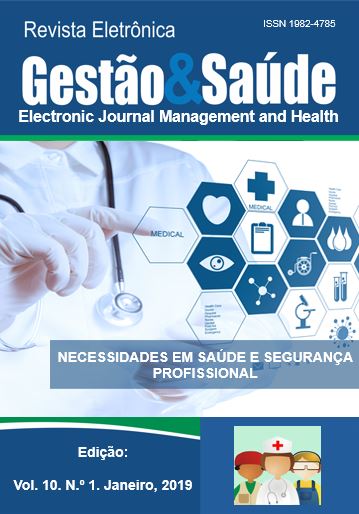Perception of nursing professionals on the use of surgical safety checklist
DOI:
https://doi.org/10.26512/gs.v10i1.22541Keywords:
Surgicenters; Safety Management; Cehcklist; Nursing.Abstract
The purpose of this study was to evaluate nursing team knowledge about the applicability and importance of the Safe Surgical Program and the use of the Surgical Safety Checklist. It is a descriptive and quantitative study carried out in the surgical center of a public university hospital involving a population of 34 professionals, whose data were collected by means of a structured questionnaire. Twenty-six nursing assistants and two nurses participated in the study. The study highlighted positive aspects as for the knowledge and credibility granted by professionals as to the Surgical Safety Checklist use as a tool. The professionals also referred to the difficulties arising from the use of such Checklist, as the absence of verbal communication among the team concerning the patient and available time for the checking of the instruments before the surgery. The results allowed to highlighting, analyzing and discussing the gaps still permeating the process of adherence to the Checklist in the surgical center routine. It is necessary to plan and implement systems that contribute to the Checklist adoption as a tool for the safety of the surgical patient.
Downloads
References
Ciampone MHT, Peduzzi M. Planejamento Estratégico como instrumento de gestão e assistência. In: Brasil. Instituto para o Desenvolvimento da Saúde. Universidade de São Paulo. Ministério da Saúde. Manual de Enfermagem: Programa Saúde da Família. São Paulo; 2001. p. 23-28.
World Health Organization. Patient safety. [Internet]. Copenhagen; 2014 [citado 10 mar. 2015]. Disponível em: http://www.euro.who.int/en/healthtopics/Health-systems/patientsafety/patient-safety.
Gallotti, RMD. Eventos adversos: o que são? Rev. Assoc. Med. Bras. 2004; 50(2):114-114.
Ursi ES. Galvão CM. Prevenção de lesões de pele no perioperatório: revisão integrativa da literatura. Revista LatinoAmericana de Enfermagem, 2006;14(1):124-31.
Organização Mundial da Saúde. Orientações da OMS para a Cirurgia Segura 2009 – Cirurgia Segura Salva Vidas / Organização Mundial da Saúde – Direção Geral da Saúde. Versão Portuguesa.2009. 196p.
Ursi ES. Galvão CM. Prevenção de lesões de pele no perioperatório: revisão integrativa da literatura. Revista LatinoAmericana de Enfermagem, 2006;14(1):124-31.
Organização Mundial da Saúde. Orientações da OMS para a Cirurgia Segura 2009 – Cirurgia Segura Salva Vidas / Organização Mundial da Saúde – Direção Geral da Saúde. Versão Portuguesa.2009. 196p.
Organização Mundial da Saúde. Segundo desafio global para a segurança do paciente: Manual - cirurgias seguras salvam vidas (orientações para cirurgia segura da OMS) / Organização Mundial da Saúde; Rio de Janeiro: Organização Pan-Americana da Saúde. Ministério da Saúde. Agência Nacional de Vigilância Sanitária, 2009. p.19 e 26.
Ursi ES. Galvão CM. Prevenção de lesões de pele no perioperatório: revisão integrativa da literatura. Revista LatinoAmericana de Enfermagem, 2006;14(1):124-31.
Organização Mundial da Saúde. Orientações da OMS para a Cirurgia Segura 2009 – Cirurgia Segura Salva Vidas / Organização Mundial da Saúde – Direção Geral da Saúde. Versão Portuguesa.2009. 196p.
Organização Mundial da Saúde. Segundo desafio global para a segurança do paciente: Manual - cirurgias seguras salvam vidas (orientações para cirurgia segura da OMS) / Organização Mundial da Saúde; Rio de Janeiro: Organização Pan-Americana da Saúde. Ministério da Saúde. Agência Nacional de Vigilância Sanitária, 2009. p.19 e 26.
Downloads
Published
How to Cite
Issue
Section
License
Copyright (c) 2019 ELECTRONIC JOURNAL MANAGEMENT AND HEALTH

This work is licensed under a Creative Commons Attribution-NoDerivatives 4.0 International License.
I declare that this article is original and has not been submitted for publication in any other national or international journal, either in whole or in part. I further declare that once published in the Electronic Journal Management and Health published by the University of Brasília, it will never be submitted by me or any of the other coauthors to any other means of scientific dissemination.
Through this instrument, in my name and in the name of the other coauthors, may I soon copy the copyright of the article to Electronic Journal Management and Health and declare that I am aware that failure to comply with this commitment will subject the violator to penalties and penalties Law of Protection of Rights Authorities (Nº9609, of 02/19/98).


